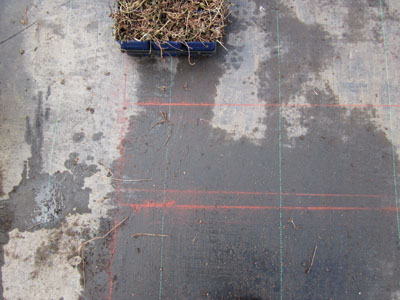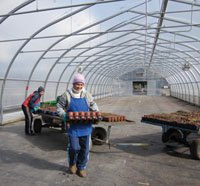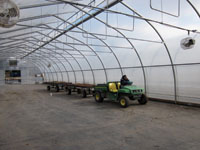
Welcome back! In this month’s article we look at the Measure and Improve phase of the Valleybrook Lean project. The reason we measure is to create a baseline, our starting point to an
understanding of our current state. By knowing this we can ensure the
changes make a quantifiable improvement to the system.
Welcome back! In this month’s article we look at the Measure and Improve phase of the Valleybrook Lean project.

|
| A PDSA trial marking permanent lines on the ground. Advertisement
|
The reason we measure is to create a baseline, our starting point to an understanding of our current state. By knowing this we can ensure the changes make a quantifiable improvement to the system.
Deciding what to measure is important. If you measure too many things it can be daunting and disengages the team; measuring too little can cause the team to miss opportunities. The simple way to identify what to measure is to use the process map that was created during the Define day. The team walks through the process steps one at a time and identifies any of the two types of things that can be measured.
MEASURING EFFICIENCY AND EFFECTIVENESS
■ Measurement can be broken down into two straightforward categories, efficiency or effectiveness, or simply how fast and how well.
The team came up with several measures of the laying-down process:
- Time to drive from potting to the greenhouse.
- Time to lay flats down.
- Time to drive back to the potting shed.
- Flats laid down per labour hour.
- Optimal number of trailers to bring – one, two or three.
- Double-decker versus one-level trailer.
The team also wanted to identify any issues or defects that may come up during the laying-down
process. Defects were noted as:
- Flats too close to the wall.
- Too many flats laid down before a walking row was left.
- Too many flats out into the centre aisle.
 |
|
| A PDSA trial with two people offloading plant material.
|
DETERMINING BASELINE IS THE FIRST STEP
■ With the measure sheets in hand, a trusty stopwatch, and a clipboard, the team went out to discover their baseline. They set up to run the process as normal and measure the total time to lay down. Once the baseline was established, the team went back to the classroom and decided on the PDSA cycles.
PDSA stands for Plan-Do-Study-Act. A PDSA is a four-step action plan that is designed as follows:
PLAN: This stage is simply stating what process you are planning on changing.
DO: This is the action plan – what you are going to try, who will do it, when will it be done, and what will you measure.
STUDY: Once the DO is completed, this is a simple step of asking “is this an improvement?”
ACT – Does the team need to try other improvements or did the changes achieve the AIM?
SEVERAL REMEDIES SOON IDENTIFIED BY THE TEAM
■ The team came up with several PDSAs:
- Drop the trailer and leave one worker behind to lay down.
- Bring two trailers and leave two workers behind and the driver supplies multiple greenhouses.
- Use two double-decker trailers.
- Put lines down on the floor to identify where the trays should be placed in relation to the walls and walkways.
 |
|
| A PDSA trial with two trailers and one driver.
|
The PDSA cycles took most of the day, as the team tried different approaches. The true strength of using the PDSA tool is the safety in trialling what is thought to be a great idea to see if it really is!
The team continually measured their PDSA trials to see which one netted the best gain in time. The team also continually evaluated qualitative measures as well. They identified repetitive work, working in isolation and fatigue as negatives. The solution to these identified issues was a rotation of jobs from driver to greenhouse lay-down staff every two hours. This gave the team a break in their day and helped increase staff morale.
USING QUANTITATIVE EVIDENCE TO MAKE A CHANGE
■ Once the trials were completed, the team headed back to the classroom for one last time to review the measures, pick the best change using quantitative evidence, and create an implementation plan.
Next month’s article will present the control phase and final outcome measures of this project at Valleybrook.
This project was made possible through the Food Innovation Centre of BC (www.foodinnovationcentre.ca ), with funding through the federal-provincial-territorial Growing Forward program. ■
Dale Schattenkirk is president/CEO of LTS Consulting, a certified Lean Six Sigma Black Belt, an ISO Auditor and a Certified Human Resources Professional (CHRP). www.ltsee.com
Print this page